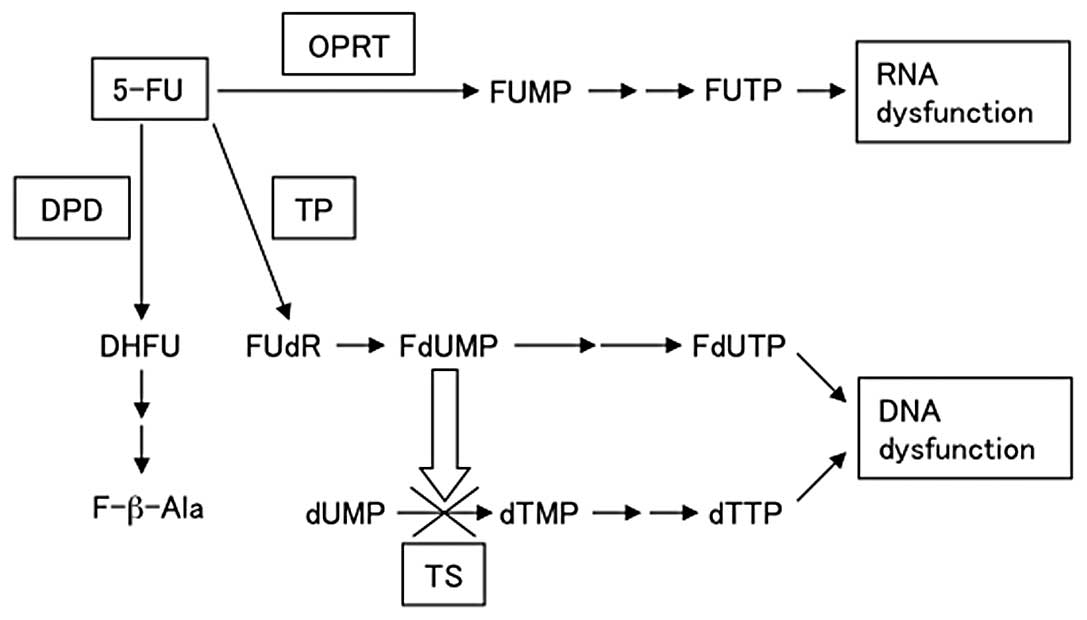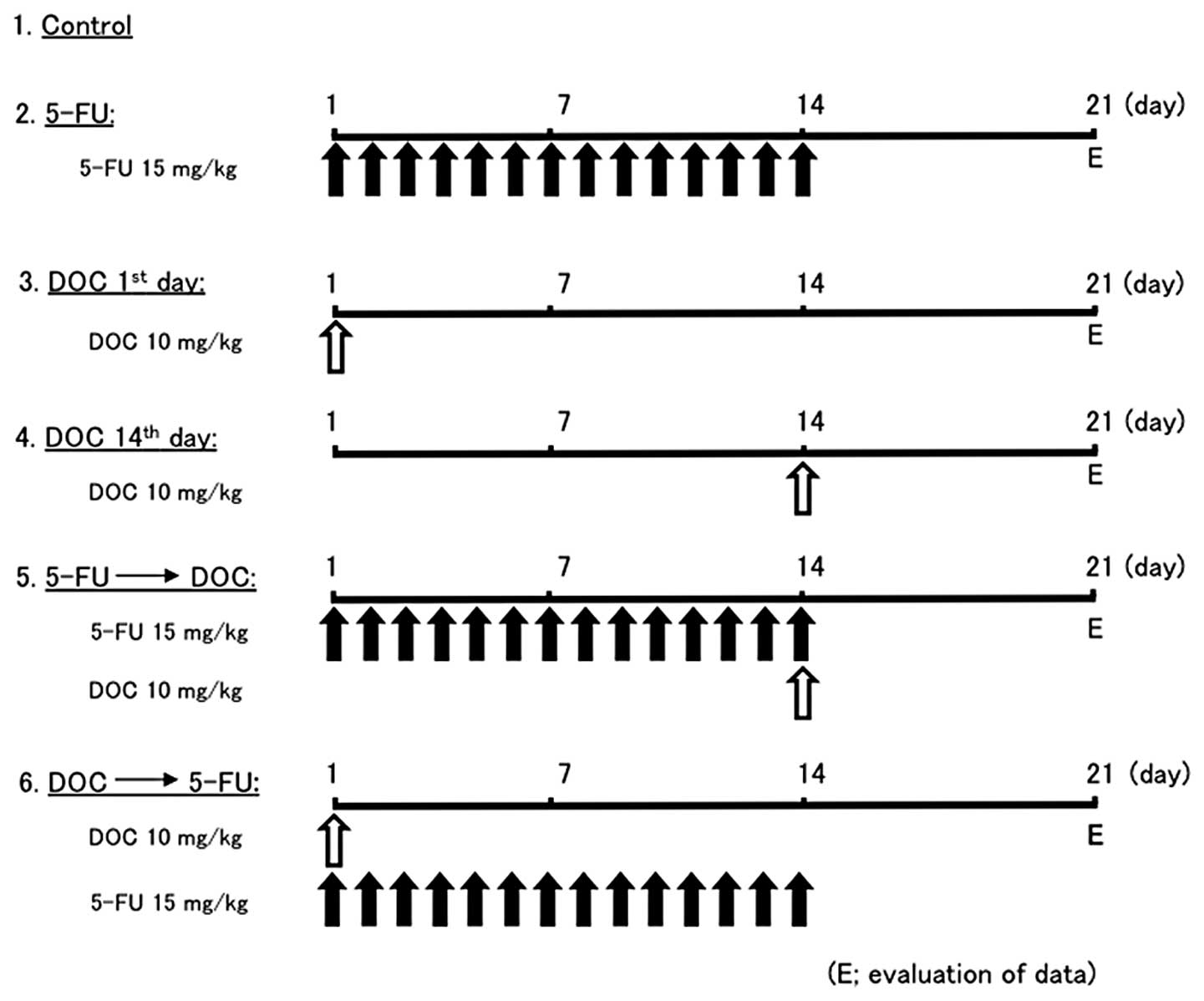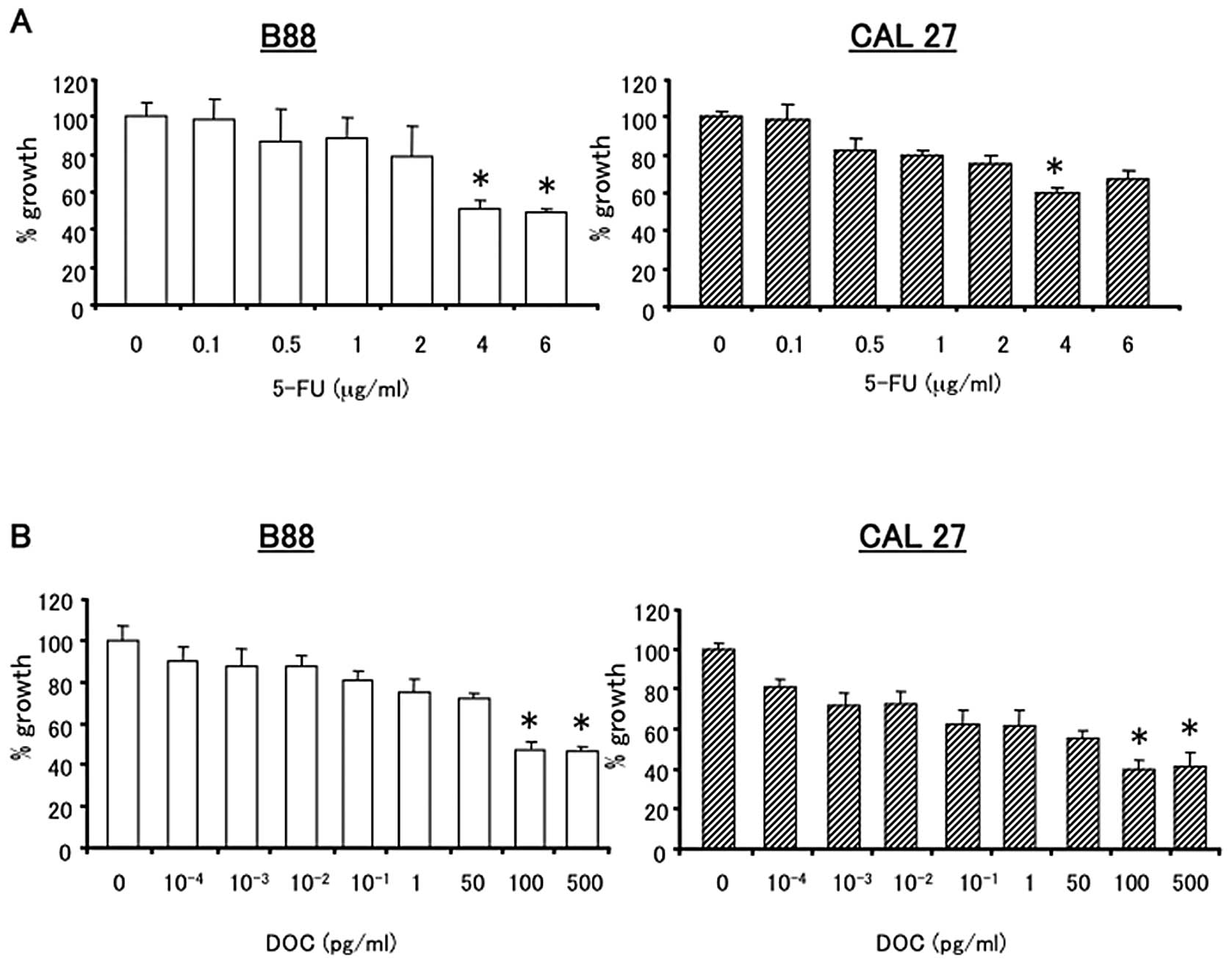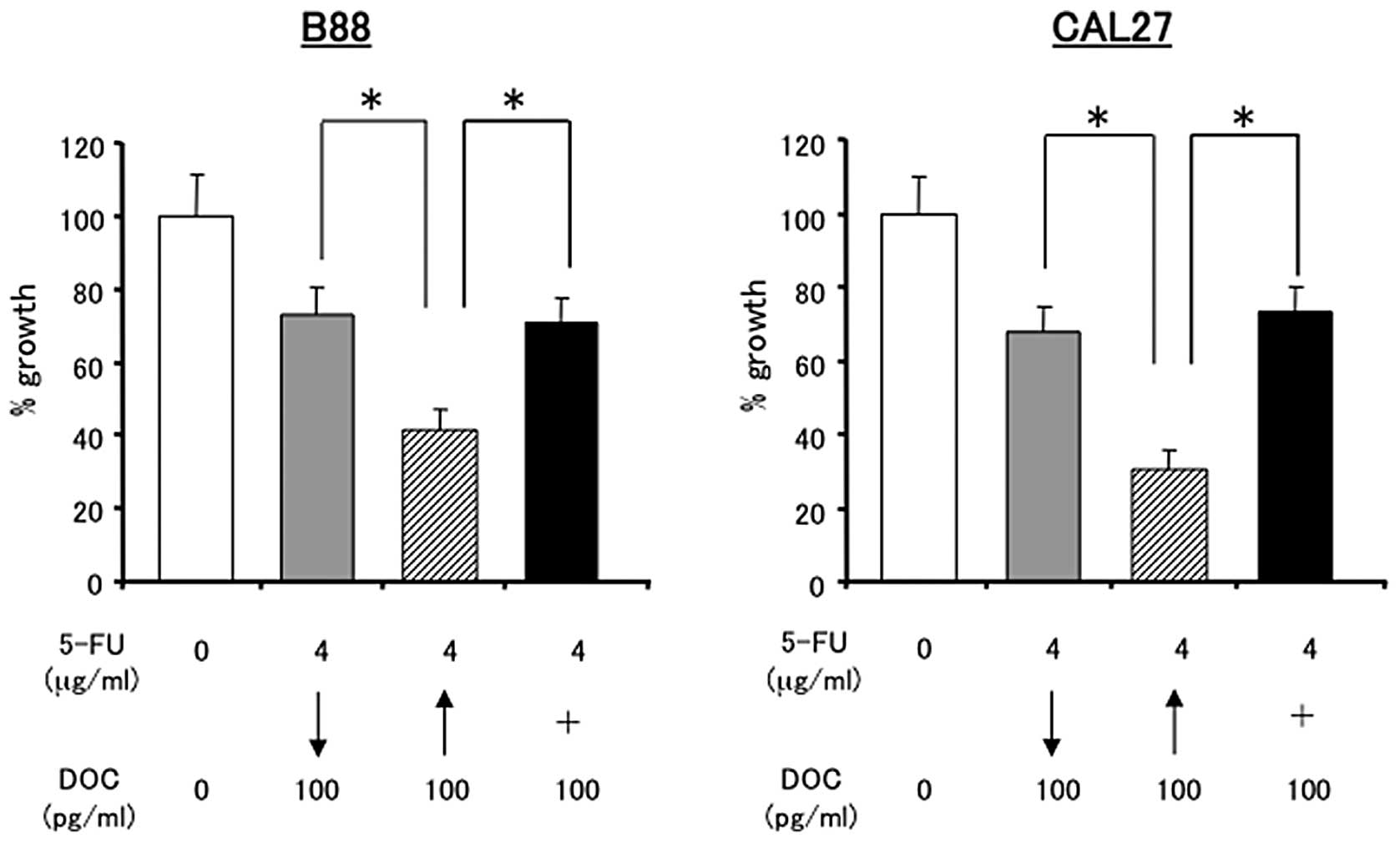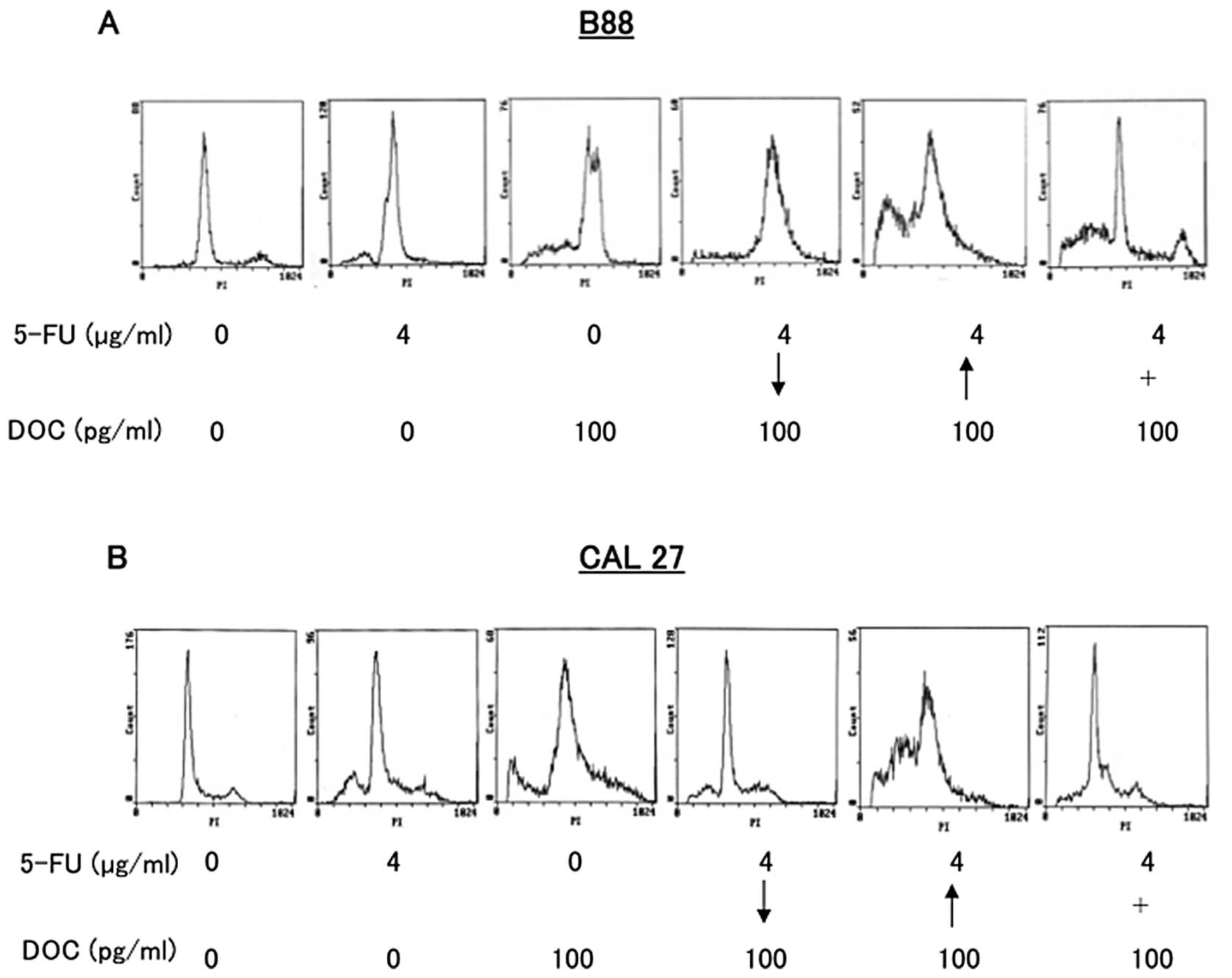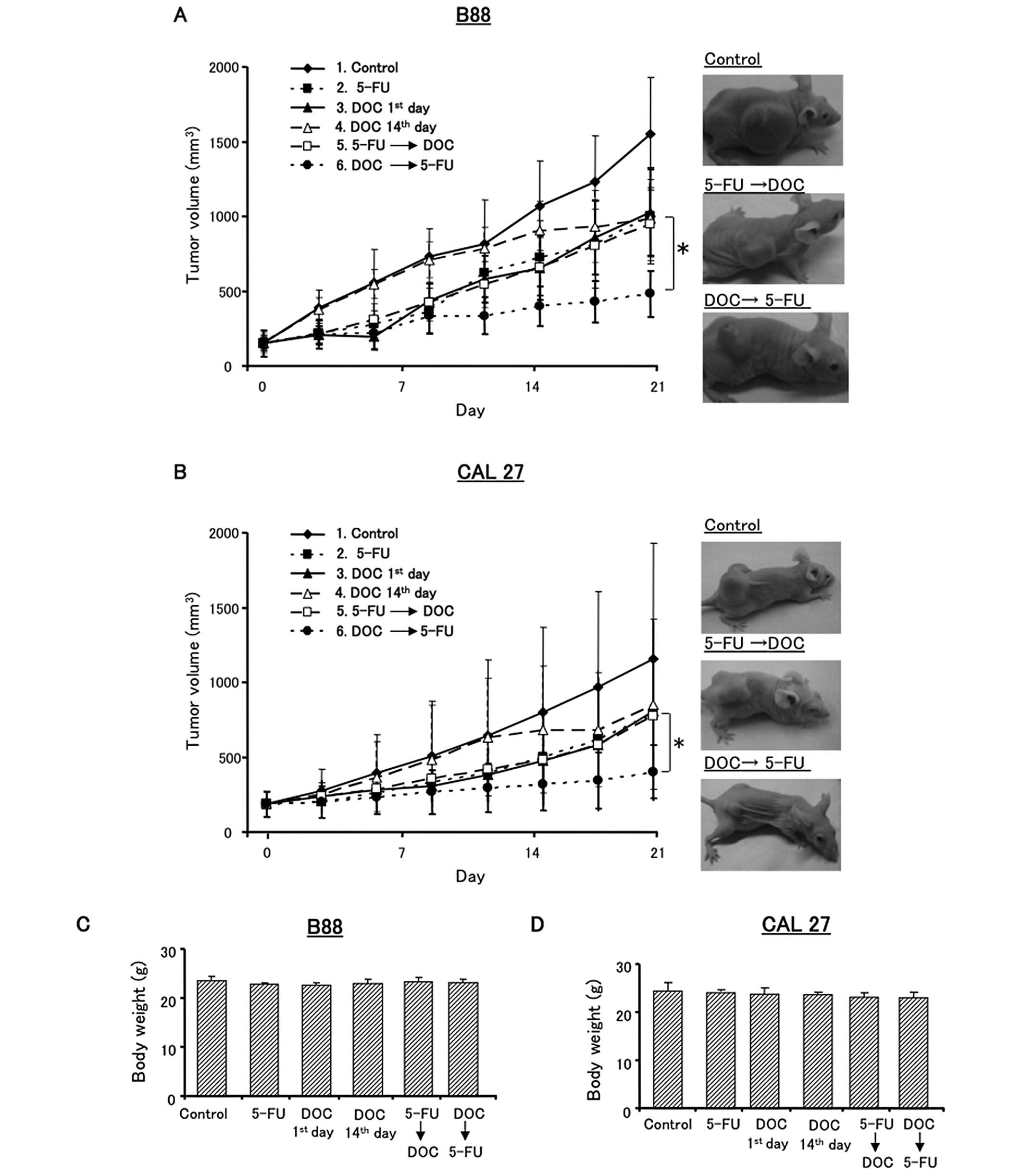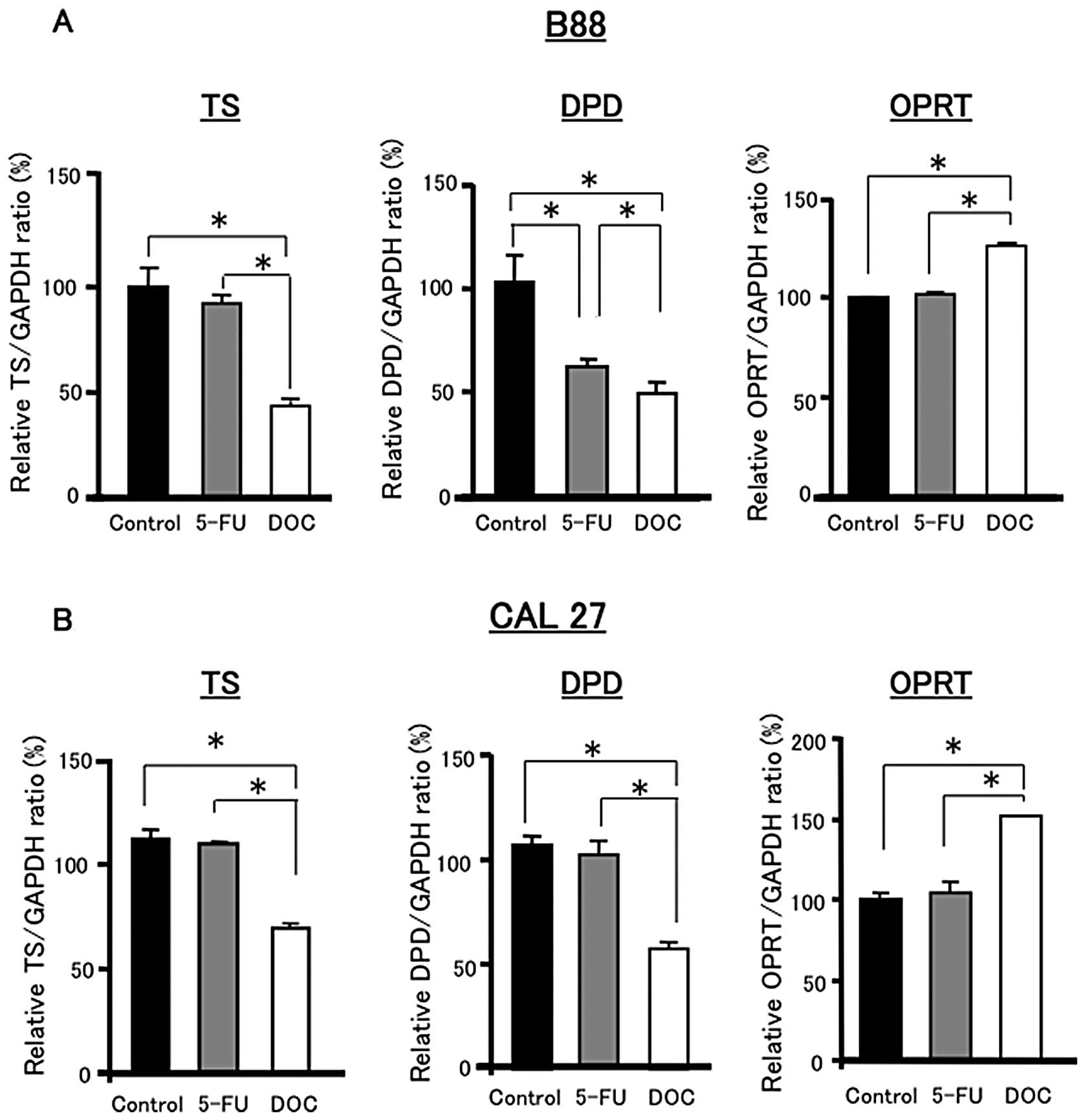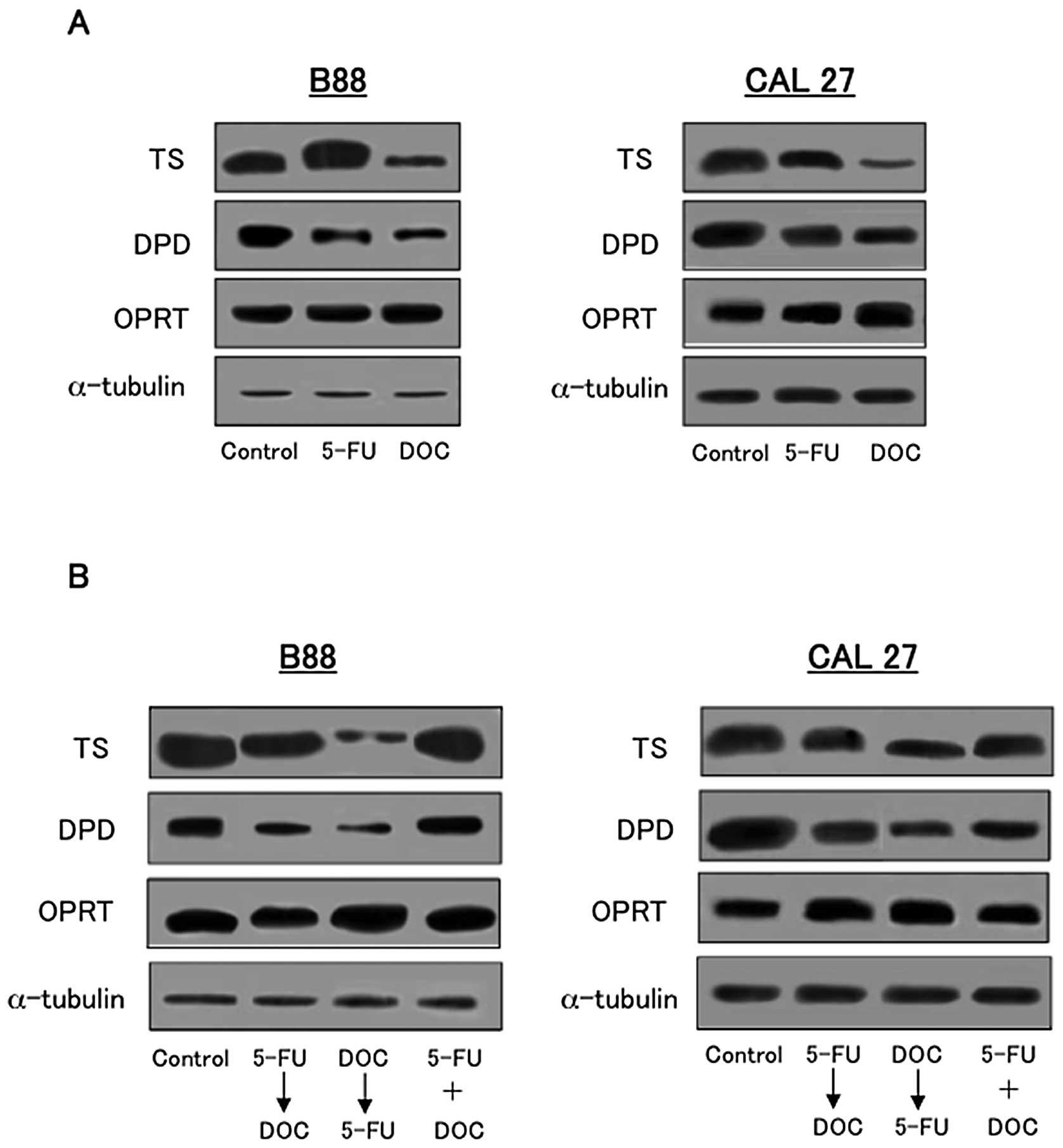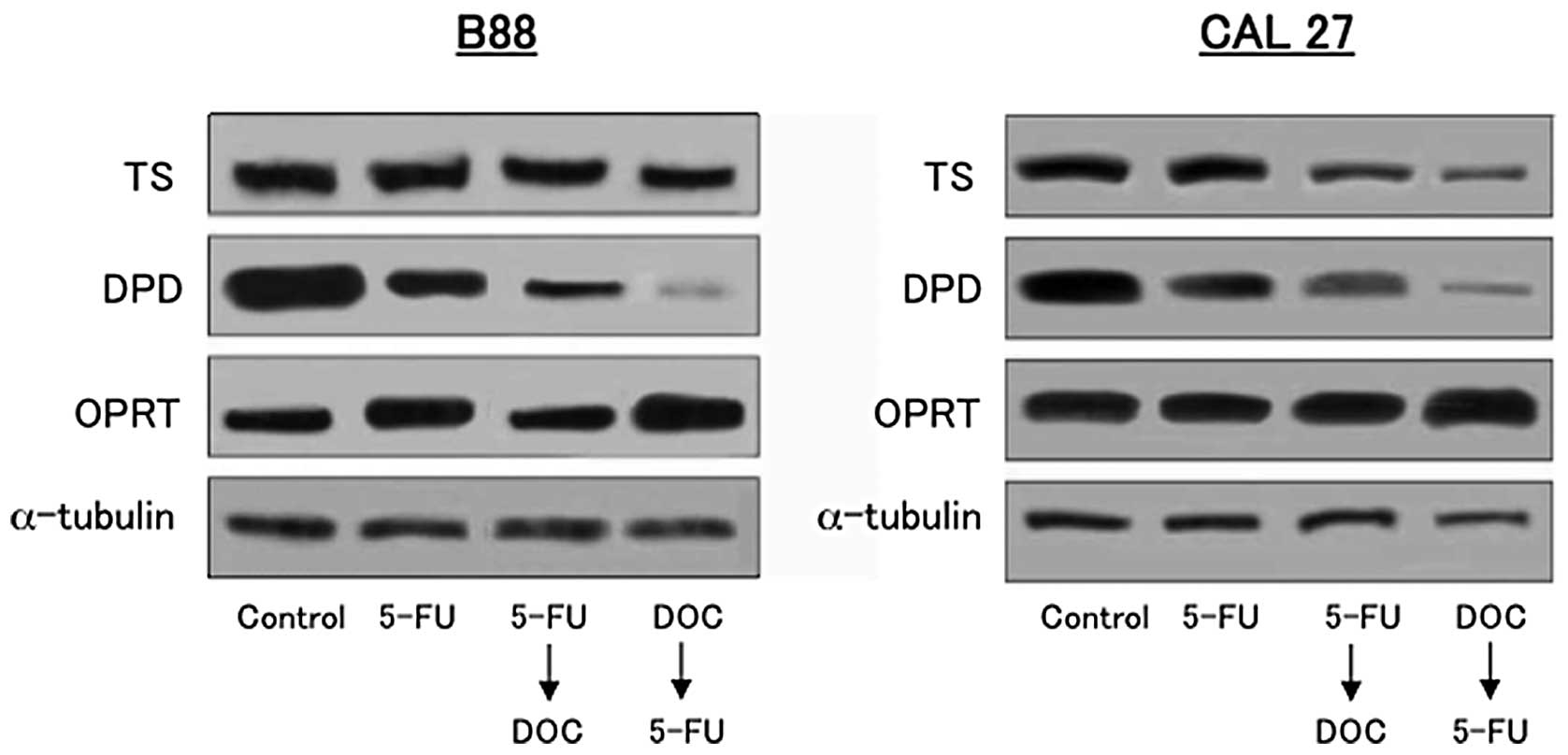|
1.
|
Azuma M, Harada K, Suprianto, Tamatani T,
Motegi K, Ashida Y and Sato M: Potentiation of induction of
apoptosis by sequential treatment with cisplatin followed by
5-fluorouracil in human oral cancer cells. Int J Oncol.
24:1449–1455. 2004.PubMed/NCBI
|
|
2.
|
Inagi K, Takahashi H, Okamoto M, Nakayama
M, Makoshi T and Nagai H: Treatment effects in patients with
squamous cell carcinoma of the oral cavity. Acta Otolaryngol
(Suppl). 547:25–29. 2002. View Article : Google Scholar : PubMed/NCBI
|
|
3.
|
Shingaki S, Takada M, Sasai K, Bibi R,
Kobayashi T, Nomura T and Saito C: Impact of lymph node metastasis
on the pattern of failure and survival in oral carcinomas. Am J
Surg. 185:278–284. 2003. View Article : Google Scholar : PubMed/NCBI
|
|
4.
|
LoTempio MM, Veena MS, Steele HL,
Ramamurthy B, Ramalingam TS, Cohen AN, Chakrabarti R, Srivatsan ES
and Wang MB: Curcumin suppresses growth of head and neck squamous
cell carcinoma. Clin Cancer Res. 11:6994–7002. 2005. View Article : Google Scholar : PubMed/NCBI
|
|
5.
|
Janinis J, Papadakou M, Panagos G,
Panousaki A, Georgoulias V, Hatzidaki D, Lefantzis D and Dokianakis
G: Sequential chemoradiotherapy with docetaxel, cisplatin and
5-fluorouracil in patients with locally advanced head and neck
cancer. Am J Clin Oncol. 24:227–231. 2001. View Article : Google Scholar : PubMed/NCBI
|
|
6.
|
Schrijvers D, Herpen CV, Kerger J, Joosens
E, Laer CV, Awada A, Weyngaert VD, Nguyen H, Bouder CL, Castelijns
JA, Kaanders J, Mulder PD and Vermorken JB: Docetaxel, cisplatin
and 5-fluorouracil in patients with locally advanced unresectable
head and neck cancer: a phase I–II feasibility study. Ann Oncol.
15:638–645. 2004.
|
|
7.
|
Yamamoto S, Kurebayashi J, Kurosomi M,
Kunisue H, Otsuki T, Tanaka K and Sonoo H: Combined effects of
docetaxel and fluoropyrimidines on tumor growth and expression of
interleukin-6 and thymidine phosphorylase in breast cancer
xenografts. Cancer Chemother Pharmacol. 48:233–238. 2001.
View Article : Google Scholar : PubMed/NCBI
|
|
8.
|
Yoshida K, Ninomiya M, Takakura N,
Hirabayashi N, Takiyama W, Sato Y, Todo S, Terashima M, Gotoh M,
Sakamoto J and Nishiyama M: Phase II study of docetaxel and S-1
combination therapy for advanced or recurrent gastric cancer. Clin
Cancer Res. 12:3402–3407. 2006. View Article : Google Scholar : PubMed/NCBI
|
|
9.
|
Ishikawa M, Miyauchi T and Kashiwagi Y:
Clinical implications of thymidylate synthetase, dihydropyrimidine
dehydrogenase and ortate phosphoribosyl transferase activity level
in colorectal carcinoma following radical resection and
administration of adjuvant 5-FU chemotherapy. BMC Cancer.
8:188–194. 2008. View Article : Google Scholar
|
|
10.
|
Ando T, Ishiguro H, Kuwabara Y, Kimura M,
Mitsui A, Sugito N, Mori R, Ogawa R, Katada T and Fujii Y:
Relationship between expression of 5-fluorouracil metabolic enzymes
and 5-fluorouracil sensitivity in esophageal carcinoma cell lines.
Dis Esophagus. 21:15–20. 2008.PubMed/NCBI
|
|
11.
|
Ichikawa W, Uetake H, Shirota Y, Yamada H,
Nishi N, Nihei Z, Sugihara K and Hirayama R: Combination of
dihydropyrimidine dehydrogenase and thymidylate synthase gene
expressions in primary tumors as predictive parameters for the
efficacy of fluoropyrimidine-based chemotherapy for metastatic
colorectal cancer. Clin Cancer Res. 9:786–791. 2003.
|
|
12.
|
Taomoto J, Yoshida K, Wada Y, Tanabe K,
Konishi K, Tahara H and Fukushima M: Overexpression of the ortate
phosphoribosyl transferase gene enhances the effect of
5-fluorouracil on gastric cancer cell lines. Oncology. 70:458–464.
2006. View Article : Google Scholar : PubMed/NCBI
|
|
13.
|
Sakakura K, Chikamatsu K, Shino M, Sakurai
T and Furuya N: Expression of thymidylate synthase and
dihydropyrimidine dehydrogenase in oral squamous cell carcinoma:
possible markers as predictors of clinical outcome. Acta
Otolaryngol. 126:1295–1302. 2006. View Article : Google Scholar : PubMed/NCBI
|
|
14.
|
Kobayashi H, Koike T, Nakatsuka A, Kurita
H, Sagara J, Taniguchi S and Kurashina K: Dihydropyrimidine
dehydrogenase expression predicts survival outcome and
chemosensitivity to 5-fluorouracil in patients with oral squamous
cell carcinoma. Oral Oncol. 41:38–47. 2005. View Article : Google Scholar
|
|
15.
|
Catimel G, Verwii J, Mattijssen V,
Hanauska A, Piccart M, Wanders J, Franklin H, Le Bail N, Clavel M
and Kaye SB: Docetaxel (taxotere): an active drug for treatment of
patients with advanced squamous cell carcinoma of the head and
neck. EORTC Early Clinical Trials Group. Ann Oncol. 5:533–537.
1994.
|
|
16.
|
Wada Y, Yoshida K, Suzuki T, Mizuiri H,
Konishi K, Ukon K, Tanabe K, Sakata Y and Fukushima M: Synergistic
effects of docetaxel and S-1 by modulating the expression of
metabolic enzymes of 5-fluorouracil in human gastric cancer cell
lines. Int J Cancer. 119:783–791. 2006. View Article : Google Scholar : PubMed/NCBI
|
|
17.
|
Ravdin PM, Burris HA, Cook G, Eisenberg P,
Kane M, Bierman WA, Mortimer J, Genevois E and Bellet RE: Phase II
trial of docetaxel in advanced anthracycline-resistant or
anthracenedione-resistant breast cancer. J Clin Oncol.
13:2879–2885. 1995.PubMed/NCBI
|
|
18.
|
Tamatani T, Azuma M, Ashida Y, Yoshida H
and Sato M: Enhanced radiosensitization and chemosensitization in
NF-κB suppressed human oral cancer cells via the inhibition of
γ-irradiation- and 5-FU-induced production of IL-6 and IL-8. Int J
Cancer. 108:912–921. 2004.
|
|
19.
|
Honma K, Koizumi K, Takeshita F, Yamamoto
Y, Yoshida T, Nishio K, Nagahara S, Kato K and Ochiya T: RPN2 gene
confers docetaxel resistance in breast cancer. Nat Med. 14:939–948.
2008. View
Article : Google Scholar : PubMed/NCBI
|
|
20.
|
Longley DB, Harkin DP and Johnston PG:
5-fluorouracil: mechanisms of action and clinical strategies. Nat
Rev Cancer. 3:330–338. 2003. View
Article : Google Scholar : PubMed/NCBI
|
|
21.
|
Van Kuilenburg AB: Dihydropyrimidine
dehydrogenase and the efficacy and toxicity of 5-fluorouracil. Eur
J Cancer. 40:939–950. 2004.PubMed/NCBI
|
|
22.
|
Ceppi P, Volante M, Ferrero A, Righi L,
Rapa I, Rosas R, Berruti A, Dogliotti L, Scagliotti GV and Papotti
M: Thymidylate synthase expression in gastroenteropancreatic and
pulmonary neuroendocrine tumors. Clin Cancer Res. 14:1059–1064.
2008. View Article : Google Scholar : PubMed/NCBI
|
|
23.
|
Yoshinare K, Kubota T, Watanabe M, Wada N,
Nishibori H, Hasegawa H, Kitajima M, Takechi T and Fukushima M:
Gene expression in colorectal cancer and in vitro chemosensitivity
of 5-fluorouracil: a study of 88 surgical specimen. Cancer Sci.
94:633–638. 2003. View Article : Google Scholar : PubMed/NCBI
|
|
24.
|
Yoo GH, Lin HS, Iskander AJ, Piechocki MP,
Oliver J, Kewson D, Lonardo F, Tainsky MA, Kim HR, Kim H and Ensley
JF: Docetaxel associated pathways in cisplatin resistant head and
neck squamous cell carcinoma: a pilot study. Laryngoscope.
115:1938–1946. 2005. View Article : Google Scholar : PubMed/NCBI
|
|
25.
|
Yoo GH, Piechocki MP, Ensley JF, Nguyen T,
Oliver J, Meng H, Kewson D, Shibuya TY, Lonardo F and Tainsky MA:
Docetaxel induced gene expression patterns in head and neck
squamous cell carcinoma using cDNA microarray and powerblot. Clin
Cancer Res. 8:3910–3921. 2002.PubMed/NCBI
|
|
26.
|
Ukon K, Tanimoto K, Shimokuni T, Noguchi
T, Hiyama K, Tsujimoto H, Fukushima M, Toge T and Nishiyama M:
Activator protein accelerates dihydropyrimidine dehydrogenase gene
transcription in cancer cells. Cancer Res. 65:1055–1062.
2005.PubMed/NCBI
|
|
27.
|
Bendardaf R, Ristamäki R, Syrjänen K and
Pyrhönen S: Bcl-2 expression significantly correlates with
thymidylate synthase expression in colorectal cancer patients.
World J Gastroenterol. 14:6218–6223. 2008. View Article : Google Scholar : PubMed/NCBI
|
|
28.
|
Shigematsu H, Yoshida K, Sanada Y, Osada
S, Takahashi T, Wada Y, Konishi K, Okada M and Fukushima M:
Rapamycin enhances chemotherapy-induced cytotoxicity by inhibiting
the expressions of TS and ERK in gastric cancer cells. Int J
Cancer. 126:2716–2725. 2010.PubMed/NCBI
|
|
29.
|
Chang JC, Wooten EC, Tsimelzon A,
Hilsenbeck SG, Gutierrez MC, Tham YL, Kalidas M, Elledge R, Mohsin
S, Osborne CK, Chamness GC, Allred DC, Lewis MT, Wong H and
O’Connell P: Patterns of resistance and incomplete response to
docetaxel by gene expression profiling in breast cancer patients. J
Clin Oncol. 23:1169–1177. 2005. View Article : Google Scholar
|
|
30.
|
Ford HER, Mitchell F, Cunningham D,
Farrugia DC, Hill ME, Rees C, Calvert AH, Judson IR and Jackman AL:
Patterns of elevation of plasma 2′-deoxyuridine, a surrogate marker
of thymidylate synthase (TS) inhibition, after administration of
two different schedules of 5-fluorouracil and the specific TS
inhibitors raltitrexed (Tomudex) and ZD93311. Clin Cancer Res.
8:103–109. 2002.
|
|
31.
|
Ahmed FY, Johnston SJ, Cassidy J, Kelly T,
Binnie N, Murray GI, Gennip AH, Abeling NG, Knight S and McLeod HL:
Eniluracil treatment completely inactivates dihydropyrimidine
dehydrogenase in colorectal tumours. J Clin Oncol. 17:2439–2445.
1999.
|
|
32.
|
Mirjolet JF, Heyob MB, Didelot C, Peyrat
JP, Abecassis J, Millon R and Merlin JL: Bcl-2/Bax protein ratio
predicts 5-fluorouracil sensitivity independently of p53 status. Br
J Cancer. 83:1380–1386. 2000. View Article : Google Scholar : PubMed/NCBI
|
|
33.
|
Domenech JD, Oliva C, Rovira A, Servat JC,
Bosch M, Filella X, Montagut C, Tapia M, Campas C, Dang L, Rolfe M,
Ross JS, Gascon P, Albanell J and Mellado B: Interleukin 6, a
nuclear factor-κB target, predicts resistance to docetaxel in
hormone-independent prostate cancer and nuclear factor-κB
inhibition by PS-1145 enhances docetaxel antitumor activity. Clin
Cancer Res. 12:5578–5586. 2006.
|
|
34.
|
Li J, Minnich DJ, Camp ER, Brank A, MacKay
S and Hochwald SN: Enhanced sensitivity to chemotherapy in
esophageal cancer through inhibition of NF-κB. J Surg Res.
132:112–120. 2006.
|



